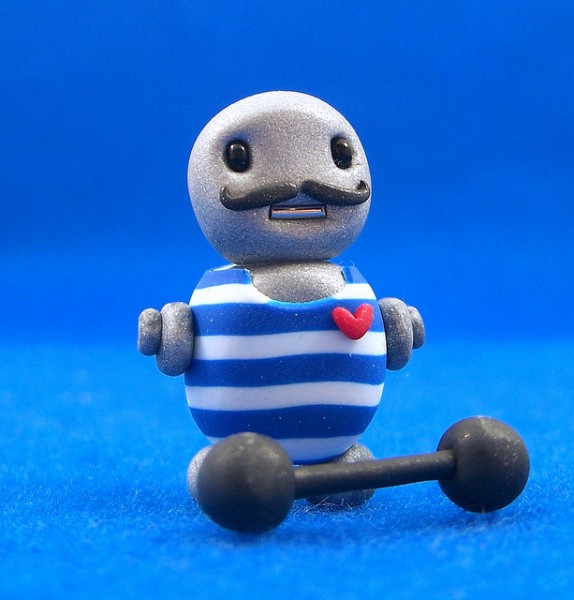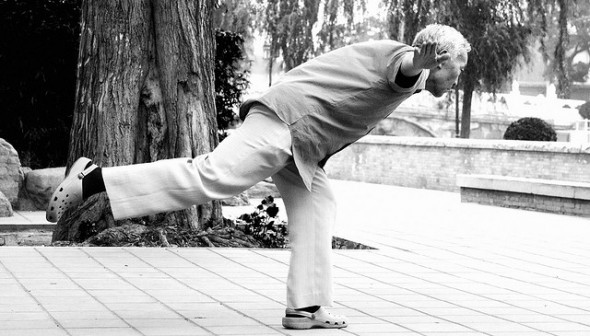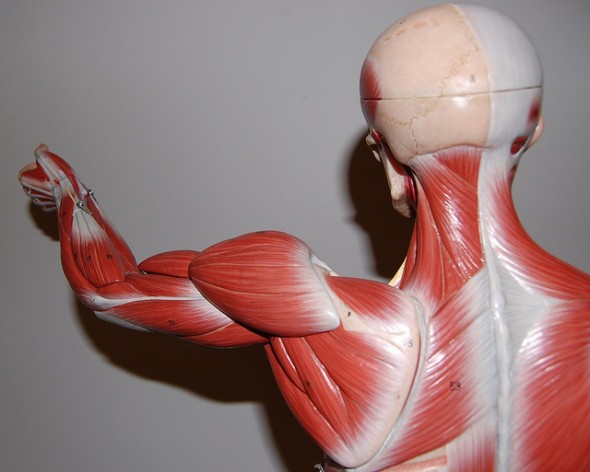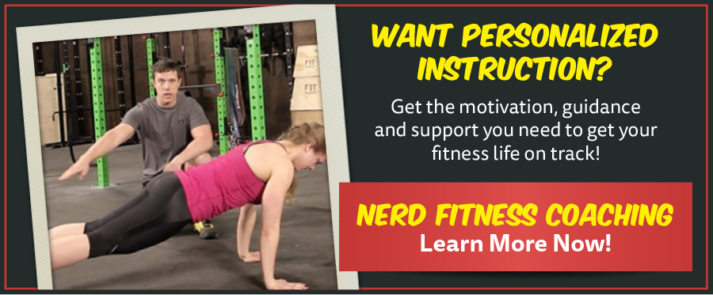This
post was originally published on
this siteOriginally posted at: http://www.nerdfitness.com/
Eat right and lift heavy.
If there’s one constant thing we say across Nerd Fitness, it’s that if you want to lose weight, gain muscle, or just look better than ever for an upcoming event, the two things you must do is eat right and lift heavy.
In this series on Strength Training, we’re going to cover ALL the things you need to know:
We’ve touched on most of these things a few times before, gone over your diet, and shown you some people it’s worked for, but we haven’t really gone into great detail.
Today that changes.
This is the first in a series of articles from NF Lead Female Coach Staci, covering all things strength training:

Oh, and she can probably lift more than you. Here she is easily deadlifting 400+ lbs at bodyweight of 150 lbs:
Staci has been part of Nerd Fitness for the past 7 years, and is now the lead female trainer in our 1-on-1 Online Coaching Program!
Our coach gets to know you, builds a program based on your experience and goals, will check your form on each movement (via video), and keep you accountable and on track!
You can learn more about our coaches and schedule a free call with us by clicking the image below:

With that out of the way, let’s jump into the amazing world of Strength Training!!!
Why strength training?

First of all, lets face it: Putting everything else aside, life is EASIER when you’re strong. Carrying groceries? One trip. Children to carry? No problem. Car stuck in the snow? Push it out with ease.
Plus, whether you’re 100 lbs overweight or just need to lose the last 15, strength training is one of the most effective ways to burn fat and build muscle.
Lifting has been shown to halt and even reverse sarcopenia – the reduction of skeletal muscle that occurs as we get older – which helps us stay independent (and out of a nursing home) and live longer.
But in addition to making life easier, strength training has a lot of great benefits right now. Here are just a few:
Look Good Naked: Strength training helps you lose weight (and body fat) in a few different ways. First, it helps you retain the muscle you have while eating a calorie deficit and losing weight.
Second, strength training has a much greater level of excess post-exercise oxygen consumption than aerobic exercise. What does this mean? When you finish a workout, your body needs to do a lot of work to replenish itself in order to bring itself back to a normal state (the way it was before you worked out). This takes a lot of energy, and some studies have shown that it can boost your metabolism for up to 38 hours after you finish your workout.
Not only that, but strength training can help increase your metabolism by speeding up your Resting Metabolic Rate (RMR). This is because it takes your body more calories to maintain muscle than it does to maintain fat. Estimates are that for every 1 lb of muscle you gain, your RMR goes up 30-50 calories!
Makes You Healthier: If you’re looking for a workout in which you get the biggest bang for your buck, strength training is it. Strength training increases bone density, builds a stronger heart, reduces your resting blood pressure, improves blood flow, halts muscle loss, helps control blood sugar, improves cholesterol levels, and improves your balance and coordination (turning you from this, to this).
You’ll Feel Better: Not only will you find yourself with more energy and confidence, less stress and anxiety, and a better overall mood, but you’ll actually begin to think better (resistance training has been proven to help increase cognitive function). And while training too close to bedtime can be a bad idea, exercising earlier in the day has been proven to help prevent sleep apnea and insomnia. I even improved my posture – when I started lifting, I was 5’4”. Now I’m 5’5.5”.
Prevents disease and degenerative conditions: Heart disease is the leading cause of death for both men and women; Strength training helps correct issues relating to cholesterol, high blood pressure, obesity, diabetes, and inactivity – all factors for heart disease. Cardiologists are even starting to recommend strength training for people who have suffered a heart attack as little as three weeks after the attack. Who knows, maybe one day your cardiologist will tell you to do some “cardio” and he’ll be referring to strength training!
Strength training has also been proven to help manage and improve the quality of life for people with Arthritis, Osteoporosis, Parkinson’s Disease, Down Syndrome, Lymphedema, fibromyalgia, who have recently had a stroke, have had a spinal cord injury, cancer survivors and clinical depression.
In addition to ALL of the above, strength training is fun! Whether you are looking for the most effective 20-30 minute workout (to stay fit and look great naked), or are looking for a competitive sport that you can really get into, strength training can help you meet your goals. It’s easy and fun to see progress as you strength train, almost like leveling up. And if you’re looking to improve in other areas (a sport, traditional cardio, or an activity like rock climbing), strength training is an easy choice!
Ok, ok. Enough already. Is there anyone who SHOULDN’T strength train?
Honestly, I did a lot of research on this one, because I wanted to find a single group of people who should not strength train. I even found studies on how strength training can be beneficial for paraplegics. Not to mention it can be safe for children, adolescents, and pregnant women. Obviously, you should take a break from strength training if you’re injured, and always check with your doctor before you start any sort of strength training program, but it’s natural for us, as humans, to move around and carry things.
Primary objections to strength training

But I’m so old! This can’t be safe!
We hear this from 30 year olds and 60 year olds alike…and, like “I don’t have time,” it is a big fat lie! Even for the frail elderly, studies have shown that drastic results are possible in just 10 weeks of weightlifting (for both men and women in their 70s through their 90s). In fact, weight training has also been shown to delay Alzheimer’s and stave off dementia. So, if you think you might be “too old,” you’re probably the exact type of person that SHOULD be strength training!
But my focus is on (running) (basketball) (quidditch) and I need to stay slim!
Studies have shown that strength training actually increases the endurance of your muscles.
In fact, resistance exercises not only help to tune up an out of shape nervous system and increase the activation of motor units within your muscles, but also helps increase their overall endurance.
If you’re worried about overall size, remember: there are many types of strength training, and size and strength don’t always go hand in hand. We’ll get into more detail on this in a minute.
I don’t want to get bulky
Ladies! The images of “bulky” women that you are conjuring up are from bodybuilding magazines. This is one of the biggest myth surrounding strength training. When I started strength training, I didn’t get bulky, I got lean, And I’m no outlier, I’m just one example of the rule: Women who strength train get strong and lean, not bulky. Like Veronica, who got damn strong and certainly lean.
Or Bronwyn, who turned into a powerlifting super mom.
That “bulky” look in women does not happen by mistake or overnight – we simply do not have the hormones necessary to get there on our own. To achieve this look, women have to eat incredible amounts of food and consume incredible amounts of drugs. When we strength train normally, without these supplements, we end up looking like athletes.
We’ll be talking more about strength training for women in a later article, but for now, just remember that everything in this article applies to both men and women.
I’m fat. I need to lose weight first.
Great! Start with strength training  When you’re overweight, my guess is that you want to be preserving the muscle you have while losing the majority of your weight through fat. With strength training, your overall weight loss may seem slower, but you will lose inches faster. Strength training increases your metabolism; as long as you’re still eating in a deficit, you’ll lose weight.
When you’re overweight, my guess is that you want to be preserving the muscle you have while losing the majority of your weight through fat. With strength training, your overall weight loss may seem slower, but you will lose inches faster. Strength training increases your metabolism; as long as you’re still eating in a deficit, you’ll lose weight.
It’s boring
We’ll be talking more about this later, but for now, just give it a shot! In strength training you can see your progress so clearly that as you can do more and more, you’ll also be rewarded by seeing your strength progress from level 1 to level 50! If you aren’t a fan of the downtime, put on a book on tape or throw on your favorite playlist while circuit training to ensure you’re always moving (instead of sitting and waiting in between sets).
Is that enough for us to convince you? Awesome.
If you read the above and said to yourself “Hell yeah, I’m ready to get started. Let’s goooo!” You’re in the right spot!
I want to send you our free guide,
Strength Training 101: Everything You Need to Know, so that you have specific plans to follow and know how to do every exercise confidently! Grab it free when you Join the Rebellion with your email in the box below. I’m excited for you to get started.
Download our comprehensive guide
- Everything you need to know about getting strong.
- Workout routines for bodyweight AND weight training.
- How to find the right gym and train properly in one.
Muscles and strength training

Before we start actually lifting anything, the first thing we need to do is have a basic understanding of how our muscles work.
Our muscles are made up of many smaller muscle cells, more commonly known as muscle fibers. They’re long and cylindrical, and about the size of a single strand of hair. Muscle fibers are comprised of myofibrils surrounded by sarcoplasm. (This is the super short version – if you’re looking for more detail, check out this page.)
We’ve got about 642 skeletal muscles, and they all work together to help our bodies move. For example, when you bend your arm, your bicep contracts and your tricep does the opposite (elongates) in order to let your elbow bend. Every muscle in your body works alongside the other.
We also have different types of fibers within our muscles, which help determine what type of training we respond best to.
The most common fiber types are:
- Slow twitch (or Type I fibers) are used for aerobic exercises where we need to convert oxygen into fuel over long periods of time. They are very resistant to fatigue, but do not move very quickly. These help for things such as running long distances.
- Fast twitch (or Type II fibers) fire very quickly, but also fatigue quickly, so they don’t last long. It gets a bit more complicated, because there are actually two types of fast twitch fibers. Type IIA fibers have some endurance qualities (used for things such as longer sprints). While Type IIX fibers are our “super fast” fibers, used only when a super short burst is needed (like a 100 m sprint or a really heavy lift).
Every person has a different percentage of fast twitch and slow twitch fibers, which is why some people tend to be naturally better at running distances than sprinting, or better at longer sets than short ones.
What is hypertrophy?

Most people believe that we can increase the amount of muscle fibers we have by weight training. In reality, we’re only born with a specific amount of muscle – by strength training, we don’t actually increase the number of muscle fibers, but we increase the size of them, increasing overall mass. This is called hypertrophy.
Now, there are a few types of hypertrophy. When someone normally just says “hypertrophy” they are most likely referring to sarcoplasmic hypertrophy.
- Sarcoplasmic hypertrophy focuses on increasing the amount of sarcoplasm, the non-contractile fluid found in your muscle. Up to 30% of your muscle’s size is attributed to the sarcoplasm, so focusing on this type of hypertrophy helps build overall size.
- Myofibril hypertrophy focuses on strengthening the myofibril, the contractile part of the muscle. In this type of hypertrophy, you are strengthening the actual muscle fiber, so it helps you build super dense, strong muscles.
- Transient hypertrophy is the temporary increase in muscle size that happens during and immediately after weight training due to fluid accumulation in the intracellular space, that you probably know as “the pump”.
So in summary, if you want to focus mainly on building super strong dense muscle, you want myofibril hypertrophy. If you only care about your muscles getting bigger, focus on sarcoplasmic. Transient hypertrophy is temporary and will appear alongside with both types.
When you strength train you’re basically doing two things to your muscles:
- Breaking down the muscle tissue so that your body will heal and rebuild the muscle back stronger. You see, our body hates being told it can’t do something. When you break down your muscle fiber it comes back stronger; when you try to do that thing again, it will succeed.
- As you start to increase the repetition (rep) range, you increase the glycogen storage in the muscle. This is where you get your increased size from.
What does this mean for me?
It means that there’s a lot more to do with strength training than just lifting things. You need to be training differently, depending on your specific goals.
Now I don’t want you to go into information overload and not end up in the gym. So, we’re going to break it down for you here:

NOTE: This chart is from Practical Programming for Strength Training by Rippetoe and Kilgore.
Rep (Repetition) – One movement through a range of motion and back again. One full squat, dropping below parallel and standing back up again is “one rep.”
X Rep Max – The heaviest load you’re able to successfully complete for X reps. So for example, a 1 Rep Max (or 1RM for short) is something so heavy that you can only complete one rep of that weight. A 10RM you can only complete 10 reps of – you would fail on the 11th.
Looking at this chart, if you want strength (myofibrillar hypertrophy), you’re going to want to keep the reps low and the weight heavy.
If you’re looking for size, which you get mainly from sarcoplasmic hypertrophy, you’re going to want to keep the weight lighter and the reps higher.
Now, one thing to understand is that each of these elements are NOT exclusive – when you train in a higher rep range you’re not JUST getting size, you’re also getting strength.
This is why I never understand why girls who don’t want to “get bulky” are told by trainers to do 3 sets of 10-12 (or 5 sets of 1,000 reps of bicep curls with a 1 lb pink dumbbell). While it’s difficult for women to gain any sort of size lifting in ANY rep range, if we were trying to gain muscle size, that’s EXACTLY what we would want to do (as it would be causing sarcoplasmic hypertrophy).
Personally, I wouldn’t worry TOO much about all of the stuff above, especially if it starts to overwhelm you!
After all, we want you to be CONFIDENT and not overwhelmed, as the sooner you start strength training, the sooner you learn the ropes and start to make progress! We cover all of this in our free guide, Strength 101: Everything You Need to Know, along with free workout plans – grab all the goodies fo’ free when you join our worldwide Rebellion with your email in the box below!
Download our comprehensive guide
- Everything you need to know about getting strong.
- Workout routines for bodyweight AND weight training.
- How to find the right gym and train properly in one.
Recovery

Have you ever heard anyone say that your muscles aren’t built in the gym, but in the kitchen?
That’s because when you’re in the gym, you’re breaking apart the muscle fibers. When you’re out of the gym, you’re healing (and getting stronger). So it’s important to take adequate rest days as a part of your strength program.
The general rule of thumb is to wait 48 hours before working the same muscle group again.
One thing to remember with this is that our muscles work together – so when you’re working on your “chest” you’re probably also working all of the muscles in your shoulders, along with your upper arms.
Recovery is different for everyone depending on many different factors such as what the actual workout is, how old you are, your sleep quality, diet, and other recovery elements (such as massage and stretching).
For a basic strength program, working out 3-4 days a week is plenty. This is one of those situations where more is not necessarily better.
Why Do I Get Sore? What’s DOMS?
DOMS is an acronym for Delayed Onset Muscle Soreness. It’s soreness that you feel in your muscles that doesn’t show up until a day or two after you work out (hence the ‘delayed onset’). It’s a normal part of the process of repairing your muscles from the damage to the fibers you created while exercising.
Expect to be more sore a few days after doing an exercise for the first time, or after not doing it for a while. As your muscles get used to that movement (and adapt to being put under stress), they will get less and less sore every time.
So, one way to make the soreness go away, at least temporarily, is to continue exercising. This increases blood flow to the muscles and helps them heal. However, remember that we still need them to heal. So if you’re sore from heavy squats, don’t turn around and do heavy squats again. Try doing squats with no weight or yoga/stretching to help bring the soreness down.
We have a whole chapter on DOMS and what you should do after a workout, and what you should do days after a workout if you’re still sore, in our free guide, Strength Training 101: Everything You Need to Know, which you can grab when you sign up in the box below:
Download our comprehensive guide
- Everything you need to know about getting strong.
- Workout routines for bodyweight AND weight training.
- How to find the right gym and train properly in one.
Ok, I get it. Can we start lifting now?

Of course, of course! If you’re ready to start, we’d recommend a simple program to follow until you get a better feel for each movement and how your body reacts to them.
There are a lot of really great programs out there for newbies. Starting Strength is probably the most well known beginner lifting program and the book is highly recommended. You can also check out our Beginner’s Guide to the Gym article for a good step by step progression to get comfortable in the gym and start working out.
Still not sure what to do? Scared you’ll injure yourself or not sure what you should be doing in the gym? Need more guidance?
If you are somebody that wants to know they are following a program that is tailor-made for their life, situation, and goals, check out our popular 1-on-1 coaching program. You’ll work with our certified NF instructors who will get to know you better than you know yourself and program your workouts and nutrition for you.

If you are looking for more guidance, but without a private coach… No worries, we’ve put together the Nerd Fitness Academy! This comprehensive, self-paced course covers:
- Improving mindset and nutrition (both essential to success for ANY program)
- A physical assessment quiz (know exactly where to start!)
- Multiple progressive workouts you can do at the gym or at home (workout anywhere!)
- Multiple difficulty levels (good for experienced rebels or complete newbies!)
Here is a sample of one of the high-quality videos in Nerd Fitness Academy. You will see the exercise performed several times and hear important cues, so that you can confident perform the workouts yourself!
Whatever program you choose, make sure:
- It’s simple to follow
- You have all of the equipment available
- It focuses on compound, full body movements
Congratulations, you just made it through the first class of Strength Training 101!
What big questions do you have about strength training?
Has strength training worked for you?
-Staci
PS – Be sure to check out the rest of Strength Training 101 series:
###
photo source: man balance, droid lift, magazine, lego relax, strongman







 While some keto or low-carb proponents claim fiber is useless at best and actively harmful at worst, I come down on the side that says fiber is probably helpful for most people. Some folks have persistently better responses to low- or no-fiber keto diets, and I won’t argue with that—I’ve seen it happen and I’ve read the studies where de-emphasizing fiber can actually improve constipation, for example.
While some keto or low-carb proponents claim fiber is useless at best and actively harmful at worst, I come down on the side that says fiber is probably helpful for most people. Some folks have persistently better responses to low- or no-fiber keto diets, and I won’t argue with that—I’ve seen it happen and I’ve read the studies where de-emphasizing fiber can actually improve constipation, for example.
 The burgeoning
The burgeoning 




 When you’re overweight, my guess is that you want to be preserving the muscle you have while losing the majority of your weight through fat. With strength training, your overall weight loss may seem slower, but you will lose inches faster. Strength training increases your metabolism; as long as you’re still eating in a deficit, you’ll lose weight.
When you’re overweight, my guess is that you want to be preserving the muscle you have while losing the majority of your weight through fat. With strength training, your overall weight loss may seem slower, but you will lose inches faster. Strength training increases your metabolism; as long as you’re still eating in a deficit, you’ll lose weight.




 For now classes are 6pm and 640pm at 2840 Wildwood st in the Boise Cloggers studio.
Book your class NOW!
click this ==>
For now classes are 6pm and 640pm at 2840 Wildwood st in the Boise Cloggers studio.
Book your class NOW!
click this ==>








